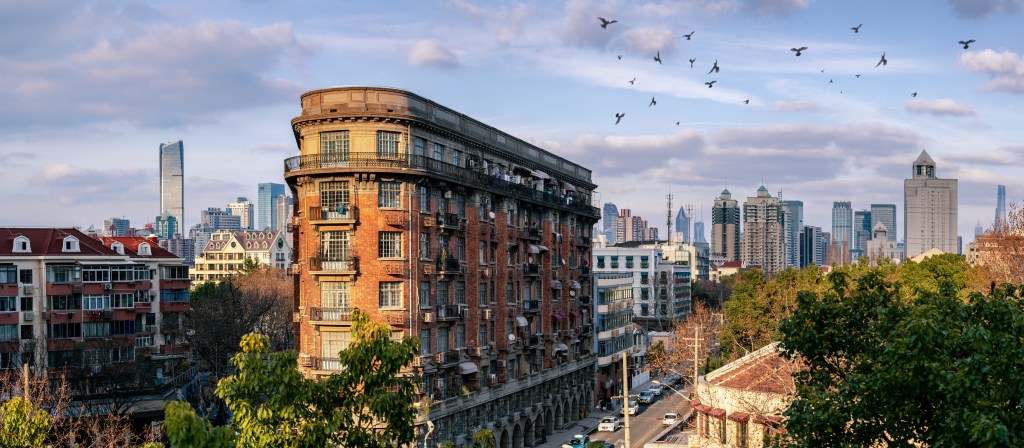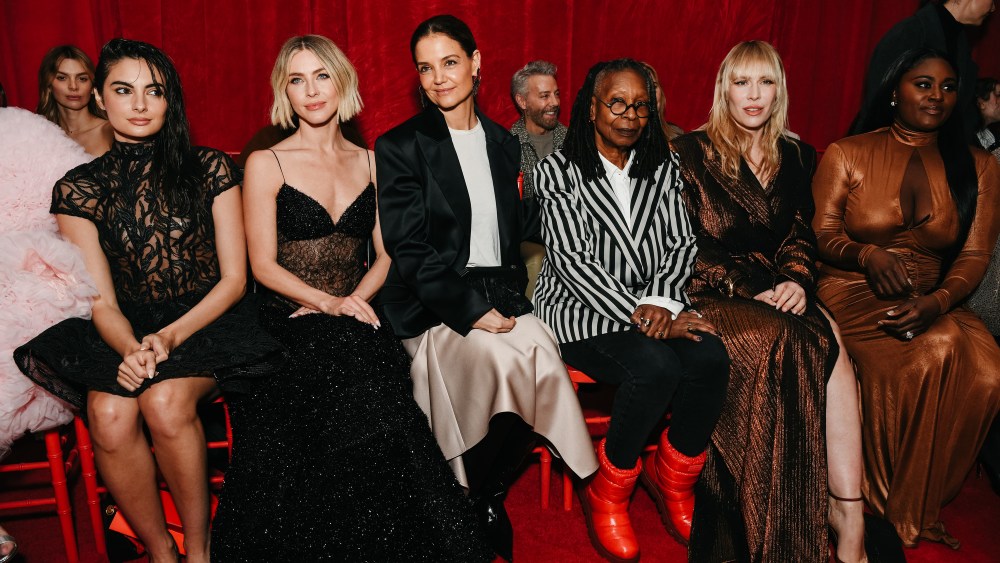There’s no better way to experience Shanghai, the bustling metropolis of 26 million people that straddles the historical and the futuristic, than by foot. It has recently been popularized by Chinese social media as taking a “city walk,” which is a self-devised trek around town, in true flâneur style that encourages checking out historical architecture and indulging in personal discoveries.
To take part in its city walk culture, WWD Weekend has devised two routes covering the latest arts and retail offerings to enable first-time visitors to experience the dynamism that helped shape Shanghai and make it the de facto fashion capital of China with diverse neighborhoods.
Rambling Through Wukang, the Historic Downtown
As a part of Shanghai’s former French Concession, the winding streets between the Changshu Road and Fuxing Road area are known for their charming European architecture stemming from when the city was under French occupation in the ’20s.
The well-preserved historical area has become Shanghai’s lifestyle center, rebranded by local Xuhui government officials as a tourism-heavy Historic Protection Zone which, according to the district, includes 64 “first-class roads” lined with towering plane trees that give it a distinctive charm.
The most iconic architecture in the neighborhood was created by the Hungarian-Slovak László Ede Hudec, who found his way to Shanghai after escaping a Siberian prison during World War I. Though Hudec’s work started in the classical revival style, it quickly began to incorporate Parisian Art Deco and the International Style, after being influenced by Le Corbusier.
Hudec’s most recognizable work is the Wukang Mansion, a wedge-shaped building at the downtown junction of Wukang Road and Huaihai Road.

Start your day trip here early to avoid the selfie-obsessed crowd that emerges at noon, then meander down Wukang Road to discover works by Hudec’s contemporary, the Frenchman Alexandre Leonard, who created more than 60 architectural marvels in Shanghai, which also helped establish the outlines of the former French Concession.
Perhaps more iconic than Hudec, Leonard suddenly disappeared from Shanghai in 1946. His farewell letter, which was sent to the French consulate-general in Shanghai, is only allowed to be revealed in 2046.
Midget Apartments, a charming Leonard project, sits at the intersection of Wukang and Hunan roads. With an imposing cement-brushed exterior and geometric coral accents, the triangular residential building is referred to by locals as “the elephant house.”

With tourist traps abounding, the smart move would be to turn right on Hunan Road after visiting Ba Jin Residence, a well-preserved cottage house the celebrated Chinese writer inhabited for more than half a century.
The leafy residential street of Hunan segways to Yongfu Road, which is home to the delightful Yongfoo Elite, a restaurant and art space created by the fashion designer-turned-businessman Xingzheng Wang, who often hosts tea ceremonies and improv performances at its traditional Chinese garden. Since last July, Yongfoo Elite began serving afternoon tea by appointment, offering sweet and savory desserts such as scallion palmier, sesame rice balls, and Chinese white Baijiu ice cream.

The tranquil Yongfu Road will lead you to Wuyuan Road, a famous filming site dotted with charming lane houses. Here, you can discover quaint boutiques such as the well-known Dave’s Custom Tailoring, a go-to tailor shop for diplomats and executives located in a three-story villa house. Wander into its neighboring lane at No. 96 Wuyuan, where you will find Bamboo Beats (WeChat reservation required), an antiques shop known for its Asian scrolls and collectible tea cups, all handpicked by its keen-eyed Millennial founder.

Make a right on Wulumuqi Road to find not-to-be-missed retail pit stops such as An Ko Rou, a playful sportswear brand founded by the local fashion group ZucZug, and the Wulumuqi Wet Market, which was christened by a Prada takeover.
Venture onto the sun-kissed path of Yanqing Road, where visitors can marvel at another Leonard legacy, the towering Savoy Apartments known for its angular Art Deco silhouette. Enjoy a walk down any lane entrance; they often lead to unexpected shops or hidden architectural gems not marked by established travel guides.

Taking An Art Walk Along Suzhou Creek
Shanghai’s avid consumerism has quickly spilled over into the art scene. Witnessing a new wave of budding patrons trading Chanel bags for pieces of art, a score of leading local and global galleries have quickly set up shop alongside Suzhou Creek, reviving the warehouse-lined waterside corridor with contemporary flair.
Compared to the charms of Wukang, Suzhou Creek, or Suez Canal, is all about megaliths such as the Embankment Building and Broadway Mansions that have come to define Shanghai’s skyline.

Formerly occupied by empty warehouses and factories, the Suzhou Creek corridor has become part of a natural extension of the city’s gallery district by the Bund, first with the establishment of UCCA Edge, M50, and OCAT Shanghai, then with the recent opening of Fotografiska Shanghai and Suhe Haus, both warehouse-turned-art establishments.
Embark on your art tour from Fotografiska, the Swedish photography art center, which is currently hosting four solo shows with more than 200 images on display, including rarely seen early works by Feng Li, the self-taught photographer known for his surrealist street photography.

Grab a vanilla or pickled pepper-flavored gelato at the art center’s Gelato Bello, before heading eastward to Suhe Haus, a newly converted warehouse that showcases a good mix of local galleries, including Objective Gallery, Longlati Foundation, Hive Center for Contemporary Art, HdM Gallery, and Galerie Balice Hertling, all hosting pop-up exhibitions of contemporary artists.

Take a coffee break at the Suhe MixC World, a futuristic shopping mall that includes a series of restored historical housing groups called “Shenyu Li,” where you can get a glimpse of the historical Thean Hou Temple, one of the oldest temples in Shanghai.

There’s no way to miss the well-marked Embankment Building, conceived by Victor Sasson, a 1930s Baghdadi-Jewish real estate tycoon. Stretching over the whole block and complete with nine elevators, it was at the time the largest residential building in Shanghai and all of Asia.
In the ’40s, it housed the foreign press and several American film production companies, including one founded by Charlie Chaplin and other Hollywood heavyweights. Since the early 2000s, the building has been a preferred address for the creative and the nomadic.
The easiest way to get a taste of the labyrinth of Embankment is by making an appointment at Gallery 101, a furniture showroom located on the first floor.
Continue upstream to the arched bridge way that is Zhapu Road Bridge, where winding streets and the smell of scallion pancakes will guide you toward Rockbund, a collection of historical buildings newly renovated by David Chipperfield, who harmonized the eclectic building cluster, which spanned Art Deco to dusty European styles, with similar brick facades.


The Rockbund Art Museum, one of Shanghai’s most established private art museums housed in the former North China Branch of the Royal Asiatic Society, also an Art Deco beauty, is an integral part of the Rockbund project.
The museum recently opened after Chipperfield’s two-year restoration, which added a back entrance and a museum plaza. It’s worth visiting Shenzhen artist Tan Jing’s slimy dreamscape on its second floor before venturing to its sixth-floor RAM Café, where you can sip cocktails while enjoying a close-up view of the famed Oriental Pearl TV Tower.

Rockbund can also be a departure point for a stroll alongside the tourist-heavy Bund. You can also conclude the art-heavy trip at Pearl Lam Galleries on Hong Kong Road, a block away from Rockbund. Currently on view is a solo exhibition by Ni Zhiqi, aptly titled “Flâneur”; Ni’s textured color blocks pay homage to the daily wonders of Shanghai living.


